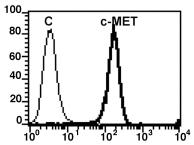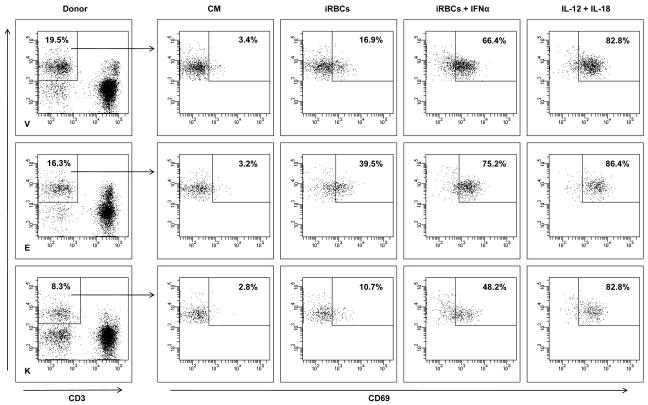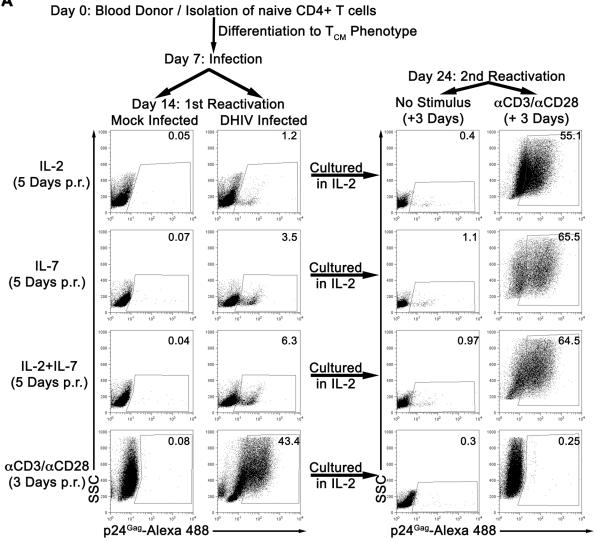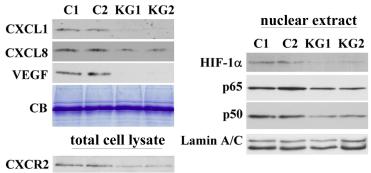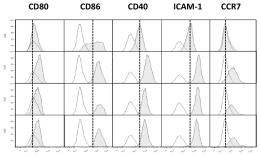Description
Accession
P01308
Source
DNA sequence encoding Human Insulin mature chain was expressed in Escherichia Coli.
Molecular weight
Native human Insulin generated by the proteolytic removal of the signal peptide and propeptide,and has a calculated molecular mass of approximately 6 kDa Recombinant Insulin is a monomer protein consisting of 51 amino acid residue subunits,and migrates as an approximately6 kDa protein under non-reducing conditions and reducing conditions in SDS-PAGE.
Purity
>95%, as determined by SDS-PAGE and HPLC
Biological Activity
Activity was determined to be 30IU/mg.
Protein Sequence
MALWMRLLPL LALLALWGPD PAAAFVNQHL CGSHLVEALY LVCG ERGFFY TPKTRREAED LQVGQVELGG GPGAGSLQPL ALEGSLQKRG IVEQCCTSIC SLYQLENYCN
Endotoxin
Endotoxin content was assayed using a LAL gel clot method. Endotoxin level was found to be less than 0.1 ng/ug(1EU/ug).
Presentation
Recombinant Insulin was lyophilized from a 0.2 μm filtered solution with no additives.
Reconstitution
A quick spin of the vial followed by reconstitution in distilled water to a concentration not less than 0.1 mg/mL. This solution can then be diluted into other buffers.
Storage
The lyophilized protein is stable for at least years from date of receipt at -20° C. Upon reconstitution, this cytokine can be stored in working aliquots at2° -8° C for one month, or at -20° C for six months, with a carrier protein without detectable loss of activity. Avoid repeated freeze/thaw cycles.
Usage
This cytokine product is for research purposes only.It may not be used for therapeutics or diagnostic purposes.
Interactor
Interactor
Biological Process
Molecular function
Methods
Cell culture, treatments, and transfections
- NMuMG normal mouse mammary gland epithelial cells (obtained from R. Derynck, University of California, San Francisco) and A549 human lung adenocarcinoma cells (obtained from H. Chapman, University of California, San Francisco) were maintained in medium'>DME medium (4.5 g/l glucose) supplemented with 10% fetal bovine serum (FBS), 100 U/ml penicillin, and 100 μg/ml streptomycin.
- Growth medium for NMuMG cells was also supplemented with 10 μg/ml insulin .
- MCF-10A human mammary epithelial cells (obtained from J. Debnath, University of California, San Francisco) were maintained in medium'>DME/F-12 medium (4.5 g/l glucose) supplemented with 5% horse serum , 10 μg/ml insulin, 20 ng/ml epidermal growth factor , 0.5 μg/ml hydrocortisone , 100 ng/ml cholera toxin , 100 U/ml penicillin, and 100 μg/ml streptomycin.
- 293TA human embryonic kidney cells were maintained in medium'>DME medium (4.5 g/l glucose) supplemented with 10% tetracycline-free FBS and 110 mg/l sodium…
In vivo differentiation of derived iPS cells
- Finally, in step six, cells were cultured in the presence of 50 ng/ml hepatocyte growth factor (HGF) (&systems), 50 ng/ml insulin-like growth factor 1 (IGF-1) , and 55 nmol/L GLP-1 in medium'>CML-1066 medium with 1 × B27 for 8 days.
- All differentiation experiments were performed in triplicate, and repeated at least twice.
Materials
-
Hank's Balanced Sodium Salt (HBSS), medium'>Dulbecco's medium'>modified medium'>Eagle's medium (DMEM) high glucose (4.5 g/L), alpha minimum essential medium, phosphate-buffered salt (PBS), penicillin/streptomycin, trypsin/EDTA (0.05%/0.53 mM),
L -glutamine, superscript III kit, NuPAGE 4%–12% Bis–Tris gel, bone morphogenetic protein-2 (BMP-2), and polyvinylidene difluoride (PVDF)membranes were obtained from . - Low-molecular weight heparin (4,500 g/mol) was obtained from (,
http://www.sanofi.com/ ). - 3-(4,5-Dimethylthiazol-2-yl)-5-(3-carboxymethoxyphenyl)-2-(4-sulfophenyl)-2H-tetrazolium, inner salt (MTS) reagents were from (,
http://www.promega.com/products ). - Total collagens and GAG quantification kits were from (,
http://www.biocolor.co.uk ). - Brilliant SYBR Green Master Mix was obtained from ( , The
http://www.stratagene.com ). - PCR primers were synthesized by MWG (,
http://www.mwg-biotech.com ). - TGF-β1 and Insulin-like growth factor-1 (IGF-1) were obtained from (,
http://www.peprotechec.com ). - Protein content was determined using the assay (, ,
http://www.piercenet.com ). - The Western blot detection system was obtained from GE Healthcare (Buckin-ghamshire, UK,
http://www3.gehealthcare.com ). - All other chemicals were obtained from standard laboratory suppliers and were of the highest purity…
In Vitro Differentiation
- To examine the ability of hBSCs to spontaneously differentiate, breastmilk cells were initially grown as spheroids (see above).
- By day 4–7, some cells had attached.
- The remaining spheroids were transferred into new wells where adherent cells appeared in 1–2 days.
- Both the initial and subsequent attached cells were cultured for another 2–3 weeks, with media changes every 3–5 days.
- For directed differentiation, primary and first- to third-passage breastmilk cell cultures were incubated in differentiation media at 37°C and 5% CO2 for 3–4 weeks.
- For mammary differentiation, cells were incubated in Roswell Park medium'>Memorial medium'>Institute medium (RPMI) 1640 with
l -glutamine supplemented with 20% FBS, 4 μg/ml insulin , 20 ng/ml epidermal growth factor (EGF) , 0.5 μg/ml hydrocortisone , 5% antibiotic-antimycotic, and 2 μL/ml fungizone. - For osteoblastic and adipogenic differentiation, cells were incubated in NH OsteoDiff or NH Adipodiff medium, respectively .
- For chondrocyte differentiation,…
Differentiation of MyoD-hiPSCs
- MyoD-hiPSCs were seeded onto CollagenI or Matrigel coated dishes without feeder cells.
- Matrigel was diluted 1∶50 with primate ES medium.
- MyoD-hiPSCs were trypsinized and dissociated into single cells.
- The cell number plated ranged from 2.0×105 to 1.0×106 per 10cm2.
- Culture medium was changed to human iPS medium without bFGF and with 10 µM Y-27632 .
- After 24 h, 1 µg/mL doxycycline was added to the culture medium.
- After an additional 24 h, culture medium was changed to differentiation medium composed of alpha Minimal Essential Medium (αMEM; ) with 5% KSR , 50 mU/L Penicillin/50 µg/L Streptomycin , and 100 µM 2-Mercaptoethanol (2-ME).
- After an additional 5 days, culture medium was changed to DMEM with 5% horse serum , 50 mU/L Penicillin/50 µg/L Streptomycin, 10 ng/mL recombinant human insulin-like growth factor 1 , 2 mM L-Glutamine and 100 µM 2-ME.
- Approximately 2 days later, myogenic properties…
Chondrogenic Differentiation on Coated Surfaces
- DIAS cells were suspended in medium'>chondrogenic medium consisting of base medium with 50 µg/ml ascorbic acid-2-phosphate , 0.4 mM proline , 50 mg/ml ITS+ Premix , 10−7 M dexamethasone , 10 ng/ml transforming growth factor β1 (TGF-β1) , 100 ng/ml recombinant human insulin-like growth factor , and 1% FBS.
- 2×105 cells were seeded in a 20 µl droplet on the dried surface.
- After 4 hours, 500 µl of medium'>chondrogenic medium was carefully added around the condensed cell mass, and 250 µl of media was exchanged every other day for 14 days.
Culture and In Vitro Differentiation of Human iPSCs
- For in vitro differentiation, iPSC colonies were detached from the feeder layers en bloc using a dissociation solution (0.25% trypsin, 100 μg/ml collagenase IV [], 1 mM CaCl2, and 20% KSR; day 0) and cultured in suspension in bacteriological dishes to form EBs in a humidified atmosphere of 3% CO2.
- From day 1 to 4 of EB formation, 3 μM dorsomorphin , 3 μM SB431542 , and 3 μM BIO ((2′Z, 3′E)-6-bromoindirubin-3′-oxime) were added.
- In addition, 1 μM retinoic acid and 1 μM purmorphamine were added on days 4 and 7, respectively, and maintained thereafter until day 16 .
- The medium was changed every 2 days.
- On day 16, the EBs were enzymatically dissociated into single cells using TrypLE Select , and the dissociated cells were cultured in suspension at a density of 1 × 105 cells/ml in proliferation medium consisting of medium'>serum-free medium (media hormone mix [MHM]; 2.
- The medium was changed every 4∼6 days for…
Cell culture
- Bone marrow mononuclear cells from Diamond-Blackfan anemia patients and healthy controls were isolated from human bone marrow aspirates using Ficoll-Paque Plus (17-1440-02, GE Healthcare) density gradient centrifugation.
- Mononuclear cells were cultured in IMDM with 3% human AB plasma, 2% human AB serum, 1% P/S, 3 U/ml200μg/ml Holo-Transferrin , 10 μg/ml Insulin, 10ng/ml SCF , 1ng/ml IL-3 , 2 μM dexamethasone and 3 U/ml Epo similar to recently described protocols for culturing human erythroid cells. Cells were cultured for 1–2 days before infection as described below and analyzed 4–5 days after infection.
Transdifferentiation of human umbilical mesenchymal stem cells into neurospheres and oligodendrocyte precursor cells
- For oligodendrocyte precursor cell commitment, neurospheres were plated onto 6-well plates containing neurobasal medium supplemented with human sonic hedgehog (100 ng/mL), basic fibroblast growth factor (10 ng/mL , , ), insulin-like growth factor (50 ng/mL) and platelet-derived growth factor-BB (10 ng/mL) for 4–5 days.
Proteins and peptides
- Fibronectin from human plasma , recombinant human insulin-like growth factor-binding protein-3 (IGFBP-3) , recombinant human nidogen-1 and galectin-3 , recombinant human matrix metalloproteinase-3 (MMP-3) catalytic domain (, armstadt, ), bovine α-chymotrypsin , plasminogen ( and , , ) and lys-plasminogen from human plasma ( iagnostica, , ) were commercially obtained.
- Protein LoBind tubes were used in all protein degradation experiments.



